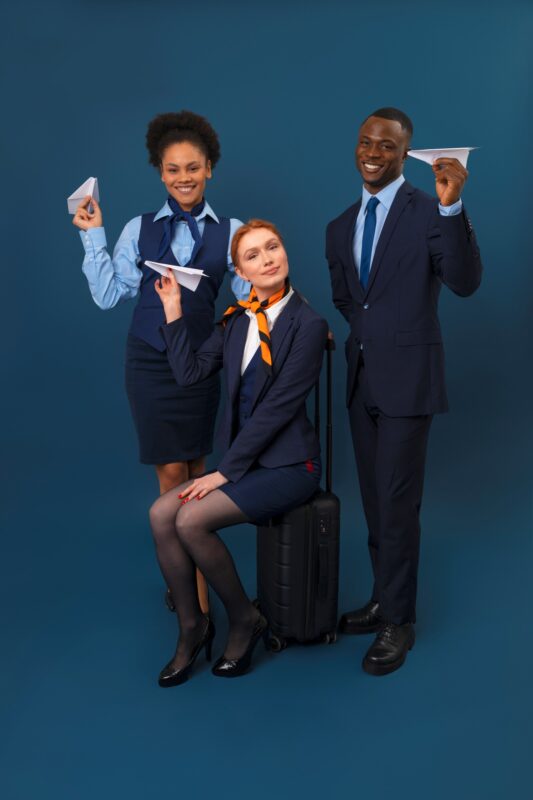The airline industry has always been synonymous with elegance, professionalism, and a sense of adventure. One of the most iconic elements of this industry is the airline uniform, which has evolved significantly over the decades. From the early days of aviation to the modern era, airline uniforms have reflected changes in fashion, technology, and cultural norms. In this blog, we’ll take a closer look at how airline uniforms have transformed over the years and how companies like Attirecorp have played a pivotal role in shaping this evolution.

The Early Days: Function Meets Form
In the 1920s and 1930s, when commercial aviation was still in its infancy, airline uniforms were heavily influenced by military attire. Pilots and crew members wore practical, utilitarian outfits designed for functionality rather than style. Think heavy wool coats, caps, and boots—perfect for the open-cockpit planes of the time.
Flight attendants, then known as “stewardesses,” were introduced in the 1930s to provide comfort and reassurance to passengers. Their uniforms were often nurse-inspired, reflecting their role in caring for passengers during flights. These early uniforms were modest, with long skirts, button-up blouses, and sensible shoes.
The Golden Age of Air Travel: Glamour Takes Flight
The 1950s and 1960s marked the golden age of air travel, and airline uniforms became a symbol of sophistication and luxury. This era saw the rise of tailored suits, fitted dresses, and accessories like gloves, hats, and scarves. Designers began to take an interest in creating uniforms that embodied the glamour of flying.
Airlines like Pan Am and TWA became trendsetters, with their flight attendants donning chic, form-fitting outfits that exuded confidence and style. The iconic Pan Am uniform, for example, featured crisp white blouses, navy blue skirts, and pillbox hats, epitomizing the elegance of the jet-setting era.
The 1970s and 1980s: Bold Colors and Cultural Shifts
As the world entered the 1970s and 1980s, airline uniforms began to reflect the bold, vibrant trends of the time. Bright colors, geometric patterns, and even bell-bottom pants made their way into cabin crew wardrobes. This era also saw a shift toward more practical designs, as airlines began to prioritize comfort and functionality alongside style.
The 1980s brought a more corporate look, with shoulder pads, blazers, and tailored trousers becoming the norm. However, the decade also saw the introduction of cultural influences, as airlines began to incorporate traditional elements from their home countries into their uniforms.
The Modern Era: Innovation and Inclusivity
Today, airline uniforms are a blend of style, comfort, and innovation. Modern fabrics like moisture-wicking materials and stretch blends are used to ensure that uniforms are both functional and fashionable. Designers are also paying closer attention to inclusivity, creating uniforms that cater to diverse body types, genders, and cultural backgrounds.
Airlines like Emirates, Singapore Airlines, and Virgin Atlantic have set new standards for contemporary uniform design. Emirates’ iconic beige-and-red uniform, for example, combines traditional Middle Eastern elements with a modern, global aesthetic. Meanwhile, Virgin Atlantic’s bold red uniforms, designed by Vivienne Westwood, are a perfect reflection of the airline’s edgy, innovative brand.
The Role of Attirecorp in Shaping Airline Uniforms
Behind every great airline uniform is a team of skilled designers and manufacturers. Attirecorp, a leading name in the uniform industry, has been at the forefront of creating stylish, functional, and durable uniforms for airlines around the world. With a deep understanding of the unique demands of the aviation industry, Attirecorp has helped airlines strike the perfect balance between tradition and innovation.
Attirecorp’s expertise lies in crafting uniforms that not only look great but also stand up to the rigors of daily wear. From selecting the right fabrics to incorporating cutting-edge design elements, Attirecorp has played a key role in shaping the evolution of airline uniforms. Their commitment to quality and attention to detail have made them a trusted partner for airlines looking to make a lasting impression.
Looking to the Future: Sustainability and Technology
As the airline industry continues to evolve, so too will its uniforms. Sustainability is becoming a major focus, with airlines seeking eco-friendly fabrics and production methods. Technology is also playing a role, with innovations like smart fabrics that can regulate temperature or monitor health.
Companies like Attirecorp are leading the charge in these areas, helping airlines create uniforms that are not only stylish and functional but also environmentally responsible. As we look to the future, it’s clear that airline uniforms will continue to be a reflection of the times—blending tradition, innovation, and a touch of glamour.
Conclusion
From the practical outfits of the early 20th century to the sleek, modern designs of today, airline uniforms have come a long way. They are more than just clothing; they are a symbol of an airline’s identity and a reflection of the era in which they were created. As the industry continues to evolve, companies like Attirecorp will remain at the forefront, helping airlines create uniforms that inspire confidence, professionalism, and a sense of adventure.
Whether you’re a frequent flyer or an aviation enthusiast, there’s no denying the impact of a well-designed airline uniform. The next time you board a flight, take a moment to appreciate the thought, creativity, and craftsmanship that goes into the attire of the crew—it’s a journey through time and style, right before your eyes.

